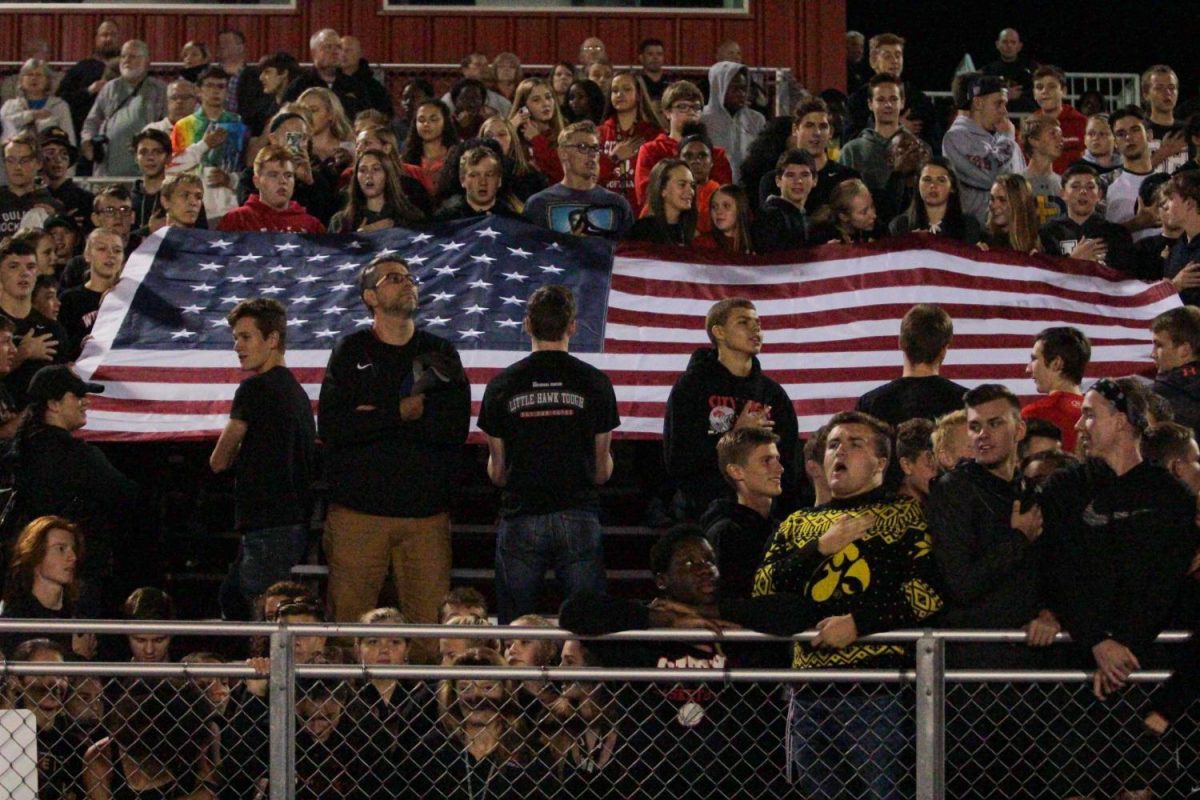What Do Anthem Protests Really Mean?
At the varsity football game student protestors knelt while counter-protestors held a flag behind them. Assistant Principal Scott Jespersen stands in between the protests.
October 18, 2017
During the last week of September millions of people tuned in to watch week three of NFL football. It was a highlight-reel Sunday, featuring a 61 yard game winning field goal and a bizarre play in which Bears cornerback Marcus Cooper returned a blocked field goal to the one yard line, only to have the ball stripped before reaching the endzone. But the most shocking thing to come from week three didn’t happen on the field. That’s because fans witnessed something that would have been unthinkable just a year ago: dozens of players, on every team, taking a knee during the singing of the national anthem. Over a month later, they’re still kneeling.
Unlike many political issues, a lot of people don’t seem to know what to make of these protests. While most people can give you a definitive answer on political questions involving immigration and the economy, many feel torn on the issue of the national anthem. I won’t try to change your opinion on this topic, but I will outline how we got here and what I believe different forms of protest actually “mean.”
The first question we have to ask ourselves is what kneeling for the anthem means in general. I’m not just talking about this Sunday, I’m talking about why people have taken a knee historically and how it has been interpreted. Hopefully by taking a look at historical examples we can create a criteria for what, if anything, constitutes an appropriate anthem protest and then apply that criteria to our current situation.
Protests during the national anthem are nothing new. There are examples dating as far back as World War One, and the idea solidified itself in the public consciousness during the 1960s. Because of the natural connection sports has with the Star Spangled Banner, most high profile examples of anthem protests come from athletes. Perhaps the most famous example came during the 1968 Summer Olympics, when Tommie Smith and John Carlos, two african-american sprinters in the 200m dash, raised their fists as the anthem played during their medal presentation ceremony. They also wore symbolic clothing and “human rights stickers”, stating that their protests were not about “back power” but the advancement of universal human rights. Clearly the idea of high profile athletes using the anthem to promote political causes is nothing new. Still, in general it is considered very taboo not to rise for the anthem. The song talks about the resilience of the American people, and is often associated with the sacrifice of military servicemembers and the concept of the american dream. It’s easy to see why refusal to stand for the anthem can be seen as a rejection of these core american values.
So what is the criteria for an appropriate anthem protest? What distinguishes a protest from being a powerful political statement versus a blatant disrespect of our nation and the veterans of its armed forces? There is a fine line between the two, but I think it’s there. There are two main types of protests: ones that are seen by many people and have an opportunity to influence others, and protests that are more about personal expression than influencing others. For our purposes, we’ll call these “vocal protests” and “silent protests.”
Because vocal protests tend to be about drawing attention to a cause, they need to shock people. They might involve taking extreme actions, even actions that the protesters would not normally condone or take part in, with the purpose of making a point about the severity of the situation. One recent example of a vocal protest is a demonstration that took place this year against Obamacare repeal bills. People in wheelchairs caused disruptions on the senate floor, forcing Capitol Police to remove them. This symbolic imagery was captured by the many news agencies reporting on the repeal efforts. This is a classic example of a vocal protest, because people used a large platform to bring attention to an issue through extreme and symbolic action.
Silent protests are more personal, and don’t need to be extreme. An example of a silent protest is refusing activate “Siri” on your iPhone because you feel that businesses shouldn’t have so much access to private information. Another example is refusing to say the Pledge of Allegiance at school because you aren’t comfortable with the phrasing or the concept of the pledge. It is important to note that even if you refused to say the pledge in front of classmates, it would still be more of a silent protest than a vocal one, because your intent is personal expression and you are not trying to convince a large audience.
So which form of protest is more appropriate for an anthem protest? In my opinion, anthem protests make more sense as vocal protests than silent protests. A “silent” anthem protest would mean an individual simply refuses to stand for the anthem because they don’t believe in what it represents. To me, this is where anthem protests can become disrespectful. Through symbolic action, the person says that they don’t believe they have any obligation to respect the ideas the anthem stands for- American ideals and military servicemembers.
Still, the NFL anthem protests are clearly vocal protests. They are a group of people with a clearly stated mission- solidarity with other athletes who have been criticized by President Trump as well as demanding justice in cases of police brutality. They are taking extreme action that can’t go unnoticed on one of the biggest stages in sports. I think that if kneeling for the national anthem were ever appropriate, it would be in the context of what NFL players are doing. What fans have to decide for themselves is whether or not they believe this action go too far to make that point, and also if they agree with the point that is being made.
The other element of this topic I want to address is the spread of this protest from the NFL to other situations. At a City High football game earlier this year, many band members and fans in the student section took a knee during the national anthem. I think students at City should be smart about how they approach this issue. If a group of students decides that a vocal anthem protest is an appropriate course of action, then I think they need to make sure that their protests is truly a “vocal protest” and not a “silent protest.”
Again, for a protest to be vocal it should have a large audience and a clear message, so the first thing students need to consider is if their audience is large enough for any protest to be be meaningful. There are a few hundred people at any given City High football game. Does the potential change created by your actions justify the extreme action you are about to take? This also has to be considered from a practical standpoint- will protestors be visible from the student section, or do they need to move to a more visible location (such as directly under the flagpole). Students also have to make sure to effectively communicate their message. This could mean passing out flyers before the game or using the announcements and other resources to ensure your message is being clearly communicated. Remember, the more the protest is an “event” the more it is a vocal (and in my opinion respectful) protest. This means setting a clear expectation for how many games you will be kneeling for and how you will go about doing it. Simply remaining seated during every performance of the national anthem without any organization becomes more of a silent protest. It also doesn’t leave you an endpoint- does anyone truly plan on kneeling until the 2020 election? Frankly, I think the execution of all of these factors could be greatly improved from the protest at the last home football game.
In summary, the ethics of anthem protests are a tricky subject. By taking a look at history we created a fair criteria for the appropriate use of this kind of protest, and we’ve narrowed the anthem debate down to one fundamental question: is the simple act of kneeling always too extreme, no matter the context? Hopefully now that we have simplified the issue you can better consider your own opinion of the NFL anthem protests, as well as consider how to respectfully go about using the national anthem in any future protests you may participate in.


































